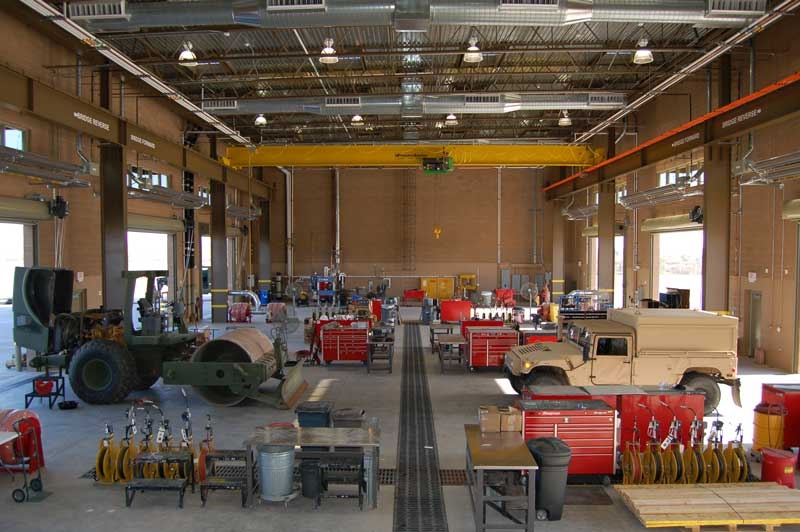The Arizona Army National Guard (AZ ARNG) Readiness Center in Florence, Ariz., has been awarded LEED Silver certification, as established by the U.S. Green Building Council (USGBC) and verified by the Green Building Certification Institute (GBCI). Science Applications International Corporation (SAIC), through its wholly owned subsidiary SAIC Energy, Environment & Infrastructure, LLC, provided design and contract administration services for the facility, including sustainable design and LEED administration services.
LEED certification of the AZ ARNG Readiness Center was based on a number of green design and construction features SAIC implemented that positively impacted the project and the broader community. These features included:
- Preferred parking stalls for low-emitting and fuel-efficient vehicles and covered parking for motorcycles to encourage use of alternative means of transportation.
- Exterior and interior lighting system designs that reduce night sky light pollution and support the nocturnal ecosystem.
- Mechanical systems that reduce energy costs by 29%, thus saving money for AZ ARNG while lessening the building’s impact on greenhouse gas emissions.
- Low-flow plumbing fixtures that result in a 40% reduction in water usage, saving money and contributing to a more secure water future.
- Solar heated water system that reduces energy costs for hot water.
- Sustainable materials that contained 30% recycled content--more than 20% of which was harvested and manufactured within 500 miles of the project site.
- Wood products used in the project harvested from Forest Stewardship Council certified forests.
- More than 85% of construction and demolition waste diverted from landfill to be either recycled or salvaged for reuse.
- Interior finish materials, paint coatings, sealants, and adhesives that meet low-volatile organic compound standards. +
Related Stories
| Jan 13, 2014
Custom exterior fabricator A. Zahner unveils free façade design software for architects
The web-based tool uses the company's factory floor like "a massive rapid prototype machine,” allowing designers to manipulate designs on the fly based on cost and other factors, according to CEO/President Bill Zahner.
| Jan 13, 2014
AEC professionals weigh in on school security
An exclusive survey reveals that Building Teams are doing their part to make the nation’s schools safer in the aftermath of the Sandy Hook tragedy.
| Jan 13, 2014
6 legislative actions to ignite the construction economy
The American Institute of Architects announced its “punch list” for Congress that, if completed, will ignite the construction economy by spurring much needed improvements in energy efficiency, infrastructure, and resiliency, and create jobs for small business.
| Jan 12, 2014
CES showcases innovations: Can any of these help you do your job better?
The Consumer Electronics Show took place this past week in Las Vegas. Known for launching new products and technologies, many of the products showcased there set the bar for future innovators. The show also signals trends to watch in technology applicable to the design and building industry.
| Jan 12, 2014
The ‘fuzz factor’ in engineering: when continuous improvement is neither
The biggest threat to human life in a building isn’t the potential of natural disasters, but the threat of human error. I believe it’s a reality that increases in probability every time a code or standard change is proposed.
| Jan 12, 2014
5 ways virtual modeling can improve facilities management
Improved space management, streamlined maintenance, and economical retrofits are among the ways building owners and facility managers can benefit from building information modeling.
| Jan 11, 2014
Getting to net-zero energy with brick masonry construction [AIA course]
When targeting net-zero energy performance, AEC professionals are advised to tackle energy demand first. This AIA course covers brick masonry's role in reducing energy consumption in buildings.
| Jan 10, 2014
What the states should do to prevent more school shootings
To tell the truth, I didn’t want to write about the terrible events of December 14, 2012, when 20 children and six adults were gunned down at Sandy Hook Elementary School in Newtown, Conn. I figured other media would provide ample coverage, and anything we did would look cheap or inappropriate. But two things turned me around.
| Jan 10, 2014
Special Report: K-12 school security in the wake of Sandy Hook
BD+C's exclusive five-part report on K-12 school security offers proven design advice, technology recommendations, and thoughtful commentary on how Building Teams can help school districts prevent, or at least mitigate, a Sandy Hook on their turf.
| Jan 10, 2014
Resiliency, material health among top AEC focuses for 2014: Perkins+Will survey
Architectural giant Perkins+Will recently surveyed its staff of 1,500 design pros to forcast hot trends in the AEC field for 2014. The resulting Design + Insights Survey reflects a global perspective.

















